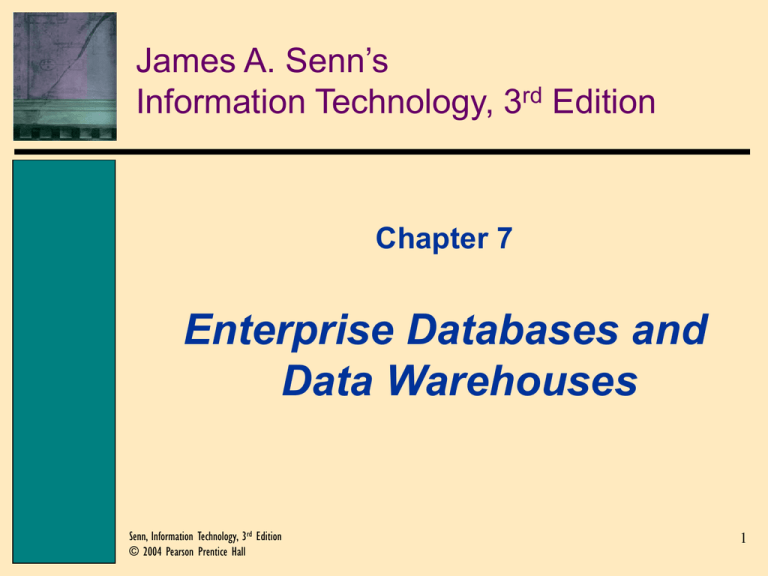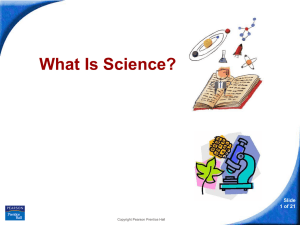
James A. Senn’s
Information Technology, 3rd Edition
Chapter 7
Enterprise Databases and
Data Warehouses
Senn, Information Technology, 3rd Edition
© 2004 Pearson Prentice Hall
1
Objectives
• Identify the reasons organizations choose to
share databases and the functions of a
database management system.
• Explain the difference between relational and
object-oriented databases and their uses in
business.
• Describe the differences between schemas,
views, and indexes.
Senn, Information Technology, 3rd Edition
© 2004 Pearson Prentice Hall
2
Objectives (Continued)
• Discuss the benefits of client/server
computing.
• Differentiate between shared and distributed
databases.
• Explain why enterprises establish data
warehouses and how they differ from data
marts and enterprise databases.
Senn, Information Technology, 3rd Edition
© 2004 Pearson Prentice Hall
3
Objectives (Continued)
• Distinguish between a database administrator
and a system programmer.
• Discuss database administration procedures
and concurrency procedures and explain why
these are an essential part of a shared
database system.
Senn, Information Technology, 3rd Edition
© 2004 Pearson Prentice Hall
4
The Principles of Data Sharing
Definition
• Database: A collection of data and information
describing items of interest to an organization.
• Entity: A person, place, thing, event or
condition about which data and information
are collected.
• Enterprise Database: A collection of data
designed to be shared by many users within an
organization.
Senn, Information Technology, 3rd Edition
© 2004 Pearson Prentice Hall
5
The Principles of Data Sharing
Definition (Continued)
Senn, Information Technology, 3rd Edition
© 2004 Pearson Prentice Hall
6
The Principles of Data Sharing
Database Management Systems
• Database Management Systems (DBMS): A program that
makes it possible for users to manage the data in a
database in order to increase accessibility and
productivity.
• The Functions of Database Management:
– Integrating Databases
– Reducing Redundancy
– Sharing Information
– Maintaining Integrity
– Enabling Database Evolution
Senn, Information Technology, 3rd Edition
© 2004 Pearson Prentice Hall
7
The Principles of Data Sharing
Database Management Systems (Continued)
Senn, Information Technology, 3rd Edition
© 2004 Pearson Prentice Hall
8
Enterprise Database Structures
Enterprise Data Model
• Enterprise Data Model/Entity Relationship: A
graphical representation of the items (the
entities) of interest about which data is
captured and stored in the database.
Senn, Information Technology, 3rd Edition
© 2004 Pearson Prentice Hall
9
Enterprise Database Structures
Enterprise Data Model (Continued)
Senn, Information Technology, 3rd Edition
© 2004 Pearson Prentice Hall
10
Enterprise Database Structures
Schema
• Schema: The structure of a database.
• Schema for Relational Database
– Relational Database: A database in which
the data are structured in a table format
consisting of rows and columns.
Senn, Information Technology, 3rd Edition
© 2004 Pearson Prentice Hall
11
Enterprise Database Structures
Schema (Continued)
Senn, Information Technology, 3rd Edition
© 2004 Pearson Prentice Hall
12
Enterprise Database Structures
Schema (Continued)
• Schema for Object-Oriented Database
– Object-oriented Database: A database that
stores data and information about objects.
– Object: A component that contains data
about itself and how it is to be processed.
– Action/Method: An instruction that tells a
database how to process an object to
produce specific information.
Senn, Information Technology, 3rd Edition
© 2004 Pearson Prentice Hall
13
Enterprise Database Structures
Schema (Continued)
Senn, Information Technology, 3rd Edition
© 2004 Pearson Prentice Hall
14
Enterprise Database Structures
Views
• View: A subset of one or more databases,
created either by extracting copies of records
from a database or by merging copies of
records from multiple databases.
Senn, Information Technology, 3rd Edition
© 2004 Pearson Prentice Hall
15
Enterprise Database Structures
Views (Continued)
Senn, Information Technology, 3rd Edition
© 2004 Pearson Prentice Hall
16
Enterprise Database Structures
Indexes
• Index: A data file that contains identifying
information about each record and its location
in storage.
• Record Key: In a database, a designated field
used to distinguish one record from another.
Senn, Information Technology, 3rd Edition
© 2004 Pearson Prentice Hall
17
Enterprise Database Structures
Indexes (Continued)
Senn, Information Technology, 3rd Edition
© 2004 Pearson Prentice Hall
18
Client/Server Computing
Definition
• File Server: A computer containing files that
are available to all users interconnected on a
local area network.
• Client/Server Computing: A type of computing
in which all data and information retrieval
requests and responses pass over a network.
Much of the processing is performed on the
server and the results of the processing are
transmitted to the client.
Senn, Information Technology, 3rd Edition
© 2004 Pearson Prentice Hall
19
Client/Server Computing
Definition (Continued)
Senn, Information Technology, 3rd Edition
© 2004 Pearson Prentice Hall
20
Client/Server Computing
Definition
Senn, Information Technology, 3rd Edition
© 2004 Pearson Prentice Hall
21
Client/Server Computing
Definition (Continued)
• Client: In client-server computing, a desktop
workstation.
• Server: A computer that hosts a network and
provides the resources that are shared on the
network.
Senn, Information Technology, 3rd Edition
© 2004 Pearson Prentice Hall
22
Client/Server Computing
The Benefits of Client/Server
Computing
Senn, Information Technology, 3rd Edition
© 2004 Pearson Prentice Hall
23
Databases on the Internet
Definition
• Web-based Integration: Makes data from
enterprise databases available to users
connecting through the Internet (including
enterprise intranets and extranets).
Senn, Information Technology, 3rd Edition
© 2004 Pearson Prentice Hall
24
Databases on the Internet
Definition (Continued)
Senn, Information Technology, 3rd Edition
© 2004 Pearson Prentice Hall
25
Distributed Databases
Definition
• Shared Database: A database shared among
many users and applications.
• Distributed Database: A database that resides
in more than one system in a distributed
network. Each component of the database can
be retrieved from any node in the network.
Senn, Information Technology, 3rd Edition
© 2004 Pearson Prentice Hall
26
Distributed Databases
Partitioning and Replication
• Partitioning: A method of database distribution
in which different portions of the database
reside at different nodes in the network.
• Replication: A method of database distribution
in which one database contains data that are
included in another database.
Senn, Information Technology, 3rd Edition
© 2004 Pearson Prentice Hall
27
Distributed Databases
Distribution Strategies
• Geographic Distribution Strategy: A database
distribution strategy in which the database is
located in a region where the data and
information are used most frequently.
• Functional Distribution Strategy: A database
distribution strategy in which the database is
distributed according to business functions.
Senn, Information Technology, 3rd Edition
© 2004 Pearson Prentice Hall
28
Distributed Databases
Designed a Distributed Database
• Database Directory: The component of a shared
database that keeps track of data and information.
• Other Design Factors
– Storage Costs
– Processing Costs
– Communication Costs
– Retrieval and Processing
– Reliability
– Frequency of Updates and Queries
Senn, Information Technology, 3rd Edition
© 2004 Pearson Prentice Hall
29
Distributed Databases
Designed a Distributed Database
(Continued)
Senn, Information Technology, 3rd Edition
© 2004 Pearson Prentice Hall
30
Data Warehouses and OLAP
Definition
• Online Analytical Processing (OLAP): Database
processing that selectively extracts data from
different points of view.
• Data Warehouse: A large data store, designed
from inquiries, that combines details of both
current and historical operations, usually
drawn from a number of sources.
Senn, Information Technology, 3rd Edition
© 2004 Pearson Prentice Hall
31
Data Warehouses and OLAP
Comparison of Enterprise Databases
and Data Warehouses
Senn, Information Technology, 3rd Edition
© 2004 Pearson Prentice Hall
32
Data Warehouses and OLAP
Data Warehouse
Senn, Information Technology, 3rd Edition
© 2004 Pearson Prentice Hall
33
Data Warehouses and OLAP
Definition
• Data Mining: Uses software designed to detect
information hidden in the data.
• Data Marts: Processed to focus on a specific
area of activities or isolated scientific or
commercial processes.
Senn, Information Technology, 3rd Edition
© 2004 Pearson Prentice Hall
34
People
Definition
• Database Administrator (DBA): The IT
professional responsible for managing all the
activities and procedures related to an
organization’s database.
• Systems Programmer
Senn, Information Technology, 3rd Edition
© 2004 Pearson Prentice Hall
35
Procedures
Database Administration Procedures
• Database Administration Procedures: The
procedures associated with managing a
database.
– Database Planning
– Database Design
– Database Creation
– Database Maintenance
– Analysis of Usage
– Creation and Monitoring of Security
Procedures
Senn, Information Technology, 3rd Edition
© 2004 Pearson Prentice Hall
36
Procedures
Concurrency Procedures
• Concurrent Data Sharing: A database
procedure that allows several users to access
the database simultaneously.
• Nonconcurrent Data Sharing: A database
procedure that allows individuals to access a
database only when no other person or
application is processing the data.
Senn, Information Technology, 3rd Edition
© 2004 Pearson Prentice Hall
37
Procedures
Concurrency Procedures (Continued)
• Record Locking: A concurrency procedure that
prohibits another user from accessing or
altering a records that is in use.
• File Locking: Used in systems that store
unstructured information and have file-level
sharing.
• Deadlock: A situation in which each user of a
database is waiting for the others to unlock a
record.
Senn, Information Technology, 3rd Edition
© 2004 Pearson Prentice Hall
38






